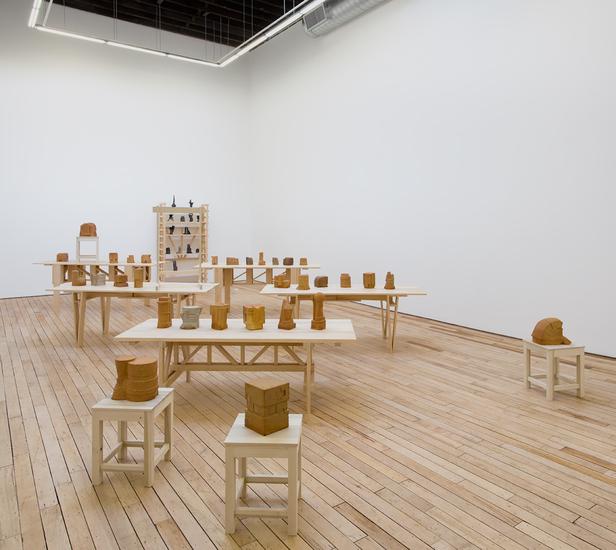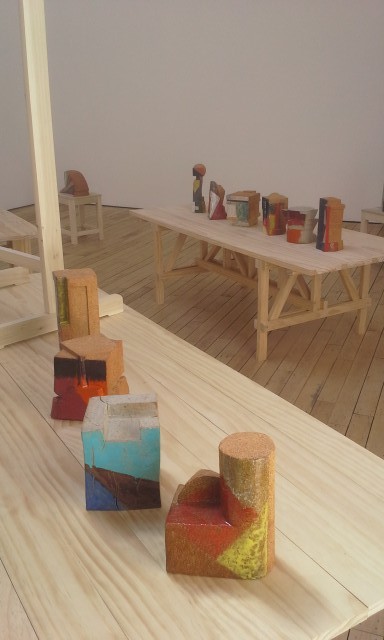Pam Lins, model model model
Rachel Uffner
170 Suffolk Street
New York, NY 10002
Runs through May 31, 2015
What’s on view: In the entrance, a series of wall-mounted shelves displaying painted-on USPS boxes and ceramic phones and what looks like styrofoam packaging for the phones. In the main room, several wooden tables and a free-standing shelf at the back contain ceramic forms; on the tables, the brownish ceramic forms have colors painted on one side only. The colors face away from the viewer.
Paddy: A stunning show of ceramic models based on photo documentation of VKhUTEMAS (The Higher Artistic and Technical Workshops), a Soviet school of art, architecture, and design founded in Moscow in 1920 that focused on model-making. These models weren’t functional—they’re supposed to “defy classification”—and this connects to the phones because those aren’t functional either.
Frankly, the connection is a bit of a stretch, and that’s consistent with the conceptual material in Lins’ 2010 show as well. (It included framed text with an introduction, chapters, and an image essay full of references only Lins could follow.)
I don’t mind this because I think a lot of the problem-solving Lins is trying to do gets done aesthetically. It’s all just a way to get there.
On the subject of what we actually see, Corinna, you mentioned that a lot of the objects in the main room looked derived from other objects—coffee makers, teapots, blenders, etc. I thought that was really perceptive, and of course, once you see that, it’s everywhere.
Initially, the arrangement of ceramics on tables seemed related to Haim Steinbach (probably because the telephones on shelves in the entrance are so obviously take cues from him). I didn’t care for that connection because the models just aren’t as interesting as anything Steinbach would find. But, as a response to documentation of a studio that at once represented obsolescence and progress, this installation is really smart. The ceramic models at the far end of the wall are done in dark greys—as they would look in the picture. Other models are painted only on the side that the photograph couldn’t capture, a visual statement that demonstrates how much more powerful our imagination is than a simple camera.
Corinna: With the VKhUTEMAS-inspired sculptures, they did seem, at times, to resemble other objects in the world—like a coffeemaker, you mentioned, or legos, or that head from Nickelodeon’s Legends of the Hidden Temple. If the aim of the VKhUTEMAS group was—and this is what I gathered, not from the show itself, but from reading up on them after the show—to create unique objects, unrelated to previous, Western European styles, then they did a pretty good job. (Although I’m reminded of Allan McCollum’s “Shapes Project,” and the impossibility of making an entirely singular object.)
Generally, I’m fascinated by trying to make an object, whether a sculpture, painting, or any other medium, that doesn’t seem to resemble anything else. On that end, Lins’s VKhUTEMAS-inspired sculptures do achieve that goal—and it was one utopian goal of the VKhUTEMAS group as well. The tables, too, were made from open-source designs, so there’s this “democracy in action” vibe where everyone can make their own unique sculpture—Lins made one-of-a-kind VKhUTEMAS sculpture, based on sculptures that no longer exist, and Lins made one-of-a-kind lumpy sculptures of phones that also presumably no longer exist—even if there is no “original.” I think that’s what’s going on here. If so, I’m not sure what’s at stake, other than a recovery of lost objects (old phones, old sculptures). It’s like making a pair of pants based on a sewing pattern from the 1970s.
Anyway, go to the show: you’ll see small objects and think some big thoughts. The objects are good enough on their own terms, even without any background knowledge.





Comments on this entry are closed.